Intermittent-Contact Resonance Atomic Force Microscopy (ICR-AFM)
Summary
The Intermittent Contact Resonance AFM (ICR-AFM) technique aims to add 3D mechanical property mapping to the surface topographies generated during force-controlled intermittent-contact AFM scans. Through combined time and frequency domain measurements, ICR-AFM provides contact stiffness and damping characterizations that can be converted into 3D quantitative elastic/viscoelastic nanoscale maps. It extends the traditional AFM-based 2D surface mechanical characterization to the sub-surface quantitative profiling of material heterogeneities, structural changes, and compositions. When paired with computation modeling and other AFM-based property characterization methods, ICR-AFM offers new avenues to examine the structure-property relationship at the nanoscale.
Description
CR-AFM is essentially a 2D material property characterization and was used mainly for quantitative measurements of materials that might have in-plane heterogeneity but otherwise are homogeneous in their sub-surface regions. However, the in-depth response of a sample can be better captured by AFM modes that probe the sample intermittently with the applied force ramped during each contact. ICR-AFM pairs the concept of CR-AFM with a force-controlled intermittent AFM mode. In CR-AFM, the changes in contact resonance frequencies are continuously observed as the tip is brought in and out of contact. The measured contact resonance frequencies are then converted into the tip-sample contact stiffness, which in turn is used to determine the elastic modulus of the sample based on a contact mechanics model. Once assembled over the scanned area, the depth-dependent ICR-AFM contact stiffness measurements provide a 3D mechanical characterization of the sub-surface region and can resolve possible material inhomogeneities.
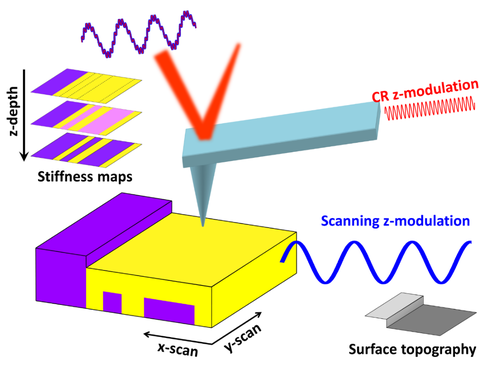
An implementation of ICR-AFM on PeakForce Tapping (PFT) AFM mode was developed in the Nanomechanical Properties Group at NIST by Gheorghe Stan and Richard Gates (US Patent 9535085, 2017). The PFT amplitude modulation operates at low fixed frequencies (between 0.5 kHz and 2.0 kHz) and prescribed peak-force (maximum applied force on the tip-sample contact). On top of the PFT operation, ICR-AFM adds an independent frequency modulation of small amplitude to the cantilever by means of a frequency-controlled tracking system like a phase-lock-loop (PLL) module. The two modulations are applied to the tip–sample contact through two separated actuators and at unrelated frequencies for crosstalk reduction: the amplitude modulation is at a non-eigenmode of the cantilever (2 kHz or less) and the frequency modulation is at one of the cantileverʼs eigenmodes (in the hundreds of kHz to few MHz range).
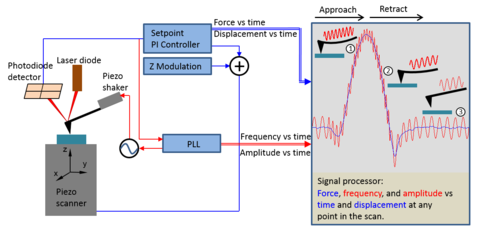
Major Accomplishments
ICR-AFM on high-aspect ratio patterns
The distinctive capabilities of ICR-AFM were proved on mapping the depth and width dependencies of the contact stiffness of nanoscale high-aspect ratio organosilicate patterns. The measured ICR-AFM signal reveals strong variations as a function of size (width of the fins) and position with respect to the edge (edge compliance).
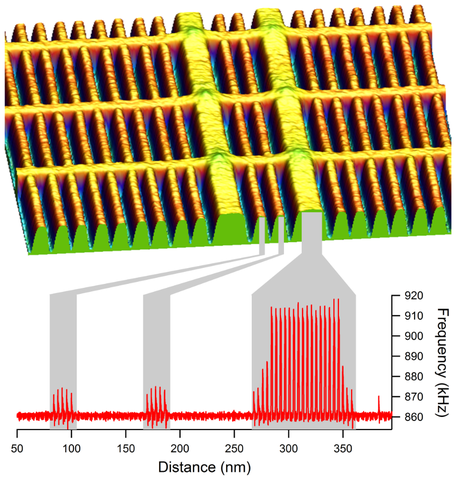
By using their space locations (x and y for in-plane positions and z for the applied force), the ICR-AFM measurements can be assembled into a 3D volume of data, being possible to slice off tomographic sections along various directions. From this ICR-AFM data volume, the construction of the 3D elastic modulus tomography is obtained through an inverse problem, which is to find the elastic profile over the sensed depth in such a way that the calculated stiffness response of the material probed will match the depth dependence of the measured contact stiffness. The results demonstrated an increased stiffening of the exposed top and sidewall surfaces over a length scale of 10 nm to 20 nm compared with the bulk values of the material. In the case of very thin patterns, as narrow as 20 nm, the stiffening extends over the entire volume. This enhance in material stiffness is directly related with the structural alterations sustained by the organosilicates during processing (plasma etching, plasma ash, wet cleaning, etc.).
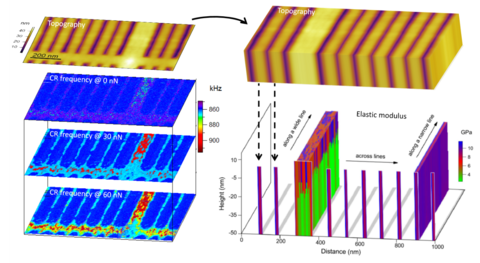
Depth sensitivity of ICR-AFM spectroscopy
A quantitative methodology to test the elastic modulus and depth sensitivity of CR-AFM against a set of low-k dielectric bilayer films was developed. The measurement analysis was accomplished by a combination of a semi-analytical and three-dimensional finite element analysis and provided a robust quantitative estimation of the subsurface depth and material sensitivities of CR-AFM. In this context, we developed a correlative measurement-model analysis to assess the convoluted contributions of the structural morphology and mechanical properties to the contact stiffness used by AFM-based subsurface imaging. The results explain the inherent difficulties associated with solving concurrently the material contrast and location of subsurface heterogeneities in nanomechanical subsurface imaging. Overall, these latest developments assert the capabilities of CR-AFM as a nondestructive and robust technique for probing layer thickness, subsurface features, and elastic properties of materials used in semiconductor electronics, additive manufacturing, or biomaterials.
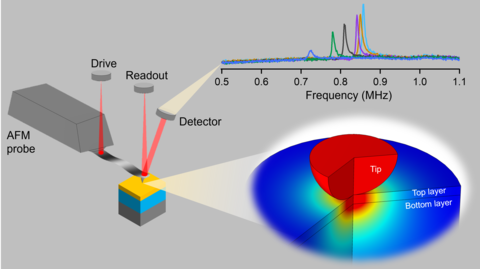
ICR-AFM for structure-property characterizations
The ICR-AFM measurements can be paired with other nanoscale characterization techniques to detail the structure-property relationship of materials at the nanoscale and how this is affected by processing. We have combined ICR-AFM with atomic-force-microscopy-based infrared spectroscopy (AFM-IR) to investigate the correlations between material properties and chemical structure during the fabrication of 20 nm to 500 nm wide patterns in a nanoporous organosilicate material. We showed that by combining these two techniques, one can clearly observe variations of chemical structure and mechanical properties that correlate with the fabrication process and the feature size of the organosilicate fins. Specifically, we have observed an inverse correlation between the concentration of terminal organic groups (Si-CH3) and the stiffness of nanopatterned organosilicate fins. The selective removal of the organic component during etching results in a stiffness increase and reinsertion via chemical silylation results in a stiffness decrease. Examination of this effect as a function of fin width indicates that the loss of terminal organic groups and stiffness increase occur primarily at the exposed surfaces of the fins over a length scale of 10 nm to 20 nm.

Future work will be focused on three areas: 1) further development and implementation of ICR-AFM on various AFM platforms (e.g. high-speed force-volume) and with other driving excitations (e.g. photothermal/thermal noise actuation of the cantilever); 2) test ICR-AFM applicability on various inhomogeneous materials and structures; 3) explore/adopt appropriate contact mechanics models (either analytically or by modeling) to convert ICR-AFM measurements into intrinsic material property parameters.
Relevant Publications
- Gheorghe Stan, Santiago D. Solares, Bede Pittenger, Natalia Erina, and Chanmin Su, Nanoscale mechanics by tomographic contact resonance atomic force microscopy, Nanoscale 6, 962 (2014) (https://doi.org/10.1039/C3NR04981G).
- Gheorghe Stan and Richard S. Gates, Intermittent contact resonance atomic force microscopy, Nanotechnology 25, 245702 (2014) (https://doi.org/10.1088/0957-4484/25/24/245702).
- Gheorghe Stan, Ebony Mays, Hui Jae Yoo, and Sean W. King, Nanoscale tomographic reconstruction of the subsurface mechanical properties of low-k high-aspect ratio patterns, Nanotechnology 27, 485706 (2016) (https://doi.org/10.1088/0957-4484/27/48/485706).
- Gheorghe Stan, Richard S. Gates, Qichi Hu, Kelvin Kjoller, Craig Prater, Kanwal Jit Singh, Ebony Mays, and Sean W. King, Relationship between chemical structure, mechanical properties and materials processing in nanopatterned organosilicate fins, Beilstein Journal of Nanotechnology 8, 863 (2017) (https://www.beilstein-journals.org/bjnano/articles/8/88).
- Gheorghe Stan and Richard S. Gates, Intermittent contact resonance atomic force microscopies and process for intermittent contact resonance atomic force microscopy, US Patent 9535085 (2017) (https://www.google.com/patents/US9535085).
- Gheorghe Stan, Ebony Mays, Hui Jae Yoo, and Sean W. King, The effect of edge compliance on the contact between a spherical indenter and a high-aspect-ratio rectangular fin, Experimental Mechanics 58, 1157 (2018) (https://doi.org/10.1007/s11340-019-00483-6).
- Gheorghe Stan, The effect of edge compliance on the adhesive contact between a spherical indenter and a quarter-space, International Journal of Solids and Structures 158, 165 (2019) (https://doi.org/10.1016/j.ijsolstr.2018.09.006).
- Gheorghe Stan and Sean W. King, Atomic force microscopy for nanoscale mechanical property characterization, Journal of Vacuum Science & Technology B 38, 060801 (2020) (https://doi.org/10.1116/6.0000544).
- Gheorghe Stan, Cristian V. Ciobanu, and Sean W. King, Resolving the Subsurface Structure and Elastic Modulus of Layered Films via Contact Resonance Atomic Force Microscopy, ACS Appl. Mater. Interfaces 14, 55238−55248 (2022) (https://pubs.acs.org/doi/full/10.1021/acsami.2c17962).
Impact and customers
- Provide state-of-the-art quantitative nanoscale mechanical property measurements on samples and devices from various academic institutions, government laboratories, and industries focused on nanoscale sciences and technologies.
- Promote the ICR-AFM methodology for a more inclusive nanoscale contact mechanics characterization. This is especially relevant for structures with non-flat surfaces, heterogeneous materials, composites, and sub-surface defects with possible applications to additive manufacturing, nanofiber structures, nanoscale patterned architectures, etc.
- Collaborations with and knowledge dissemination to AFM developers (e.g. Bruker AFM) on nanoscale mechanical property measurements and analysis.
- Working with electronics industry (e.g. Intel Corp.) on applying the 3D characterization capability of ICR-AFM to observe the effects of the fabrication process on the structure-property relationship in nanoscale structures (e.g. integrated Cu/low-k dielectric interconnects).
Contacts
-
(301) 975-3675

